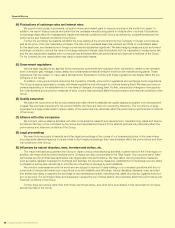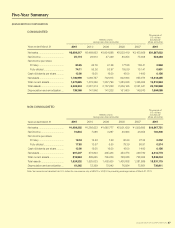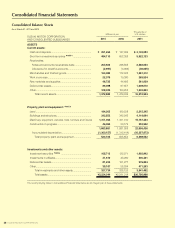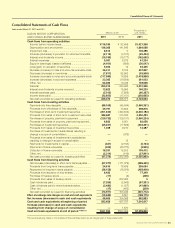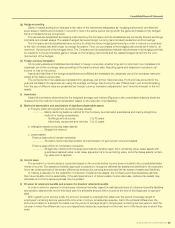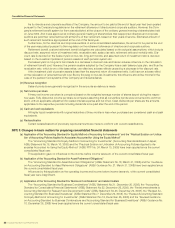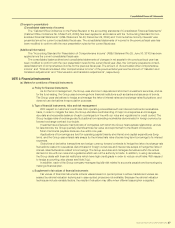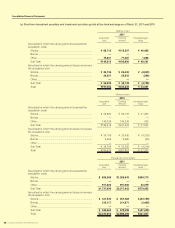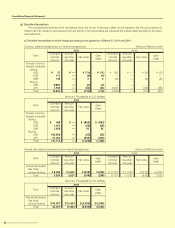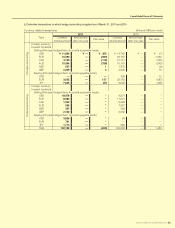Suzuki 2011 Annual Report Download - page 37
Download and view the complete annual report
Please find page 37 of the 2011 Suzuki annual report below. You can navigate through the pages in the report by either clicking on the pages listed below, or by using the keyword search tool below to find specific information within the annual report.
36 SUZUKI MOTOR CORPORATION
As for directors and corporate auditors of the Company, the amount to be paid at the end of fiscal year had been posted
pursuant to the Company’s regulations on the retirement allowance of directors and corporate auditors. However, the Com-
pany’s retirement benefit system for them was abolished at the closure of the ordinary general meeting of shareholders held
on June 2006. And it was approved at ordinary general meeting of shareholders that reappointed directors and corporate
auditors are paid their retirement benefit at the time of their retirement, based on their years of service. Estimated amount of
such retirement benefits is appropriated at the end of this fiscal year.
Furthermore, for the directors and corporate auditors of some consolidated subsidiaries, the amount to be paid at the end
of the year was posted pursuant to their regulation on the retirement allowance of directors and corporate auditors.
Retirement benefit cost and retirement benefit obligation are calculated based on the actuarial assumptions, which include
discount rate, assumed return of investment ratio, revaluation ratio, salary rise ratio, retirement ratio and mortality ratio. Dis-
count rate is decided on the basis of yield on low-risk, long-term bonds, and assumed return of investment ratio is decided
based on the investment policies of pension assets of each pension system etc.
Decreased yield on long-term bond leads to a decrease in discount rate and has an adverse influence on the calculation
of retirement benefit cost. However, the pension system adopted by the Company has a cash balance type plan, and thus the
revaluation ratio, which is one of the base ratios, can offset any adverse effects caused by a decrease in the discount rate.
If the investment yield of pension assets is less than the assumed return of investment ratio, it will have an adverse effect
on the calculation of retirement benefit cost. But by focusing on low-risk investments, this influence should be minimal in the
case of the pension fund systems of the Company and its subsidiaries.
(m) Revenue recognition
Sales of products are generally recognized in the accounts as delivery is made.
(n) Net income per share
Primary net income per share is computed based on the weighted average number of shares issued during the respec-
tive years. Fully diluted net income per share is computed assuming that all convertible bonds were converted into common
stock, with an applicable adjustment for related interest expense and net of tax. Cash dividends per share are the amounts
applicable to the respective periods including dividends to be paid after the end of the period.
(o) Cash and cash equivalents
All highly liquid investments with original maturities of three months or less when purchased are considered cash and cash
equivalents.
(p) Reclassification
Certain reclassifications of previously reported amounts are made to conform with current classifications.
NOTE 3: Changes in basic matters for preparing consolidated financial statements
(a) Application of the “Accounting Standard for Equity Method of Accounting for Investments” and the “Practical Solution on Unifica-
tion of Accounting Policies Applied to Associates Accounted for Using the Equity Method”
The “Accounting Standard for Equity Method of Accounting for Investments” (Accounting Standards Board of Japan;
ASBJ Statement No.16, March 10, 2008) and the “Practical Solution on Unification of Accounting Policies Applied to As-
sociates Accounted for Using the Equity Method” (ASBJ PITF No. 24, March 10, 2008) have been applied since the current
consolidated fiscal year.
This application gave no influences on the income before income taxes etc. of the current consolidated fiscal year.
(b) Application of the “Accounting Standard for Asset Retirement Obligations”
The “Accounting Standard for Asset Retirement Obligations” (ASBJ Statement No.18, March 31, 2008) and the “Guidance
on Accounting Standard for Asset Retirement Obligations” (ASBJ Guidance No. 21, March 31, 2008) have been applied since
the current consolidated fiscal year.
Influences by this application on the operating income and income before income taxes etc. of the current consolidated
fiscal year were insignificant.
(c) Application of the “Accounting Standard for Business Combinations” and related matters
The “Accounting Standard for Business Combinations” (ASBJ Statement No.21, December 26, 2008), the “Accounting
Standard for Consolidated Financial Statements” (ASBJ Statement No.22, December 26, 2008), the “Partial amendments to
Accounting Standard for Research and Development Costs” (ASBJ Statement No.23, December 26, 2008), the “Revised Ac-
counting Standard for Business Divestitures” (ASBJ Statement No.7, December 26, 2008), the “Revised Accounting Standard
for Equity Method of Accounting for Investments” (ASBJ Statement No.16, December 26, 2008) and the “Revised Guidance
on Accounting Standard for Business Combinations and Accounting Standard for Business Divestitures” (ASBJ Guidance No.
10, December 26, 2008) have been applied since the current consolidated fiscal year.
Consolidated Financial Statements


